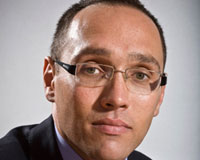A London Legacy Development Corporation board meeting will next week consider the future of the troubled Olympic media centre. There’s a favourite, of course. But even at this late stage, demolition should not be ruled out.
To those involved in the legacy project – not least the accomplished double act of Baroness Ford and Andrew Altman, chair and chief executive of what was the Olympic Park Legacy Company – the future of the 1m sq ft press and broadcast centre was always most at risk of attracting that hated label “white elephant”.
Over the past seven years, suggestions have flown thick and fast. Some wanted to see it as a tent, a temporary structure that would be taken down after the Games. Others still back a version of that: demolition. (Indeed, Daniel Moylan, who has succeeded Baroness Ford as chairman of the legacy body, has asked for a re-assessment of the cost of knocking down the £350m structure). And a fashion hub remains a possibility, though the technology-based bid, iCITY, is favourite.
This week, those most closely involved in developing the Stratford site that is home to the Olympic Park tell Estates Gazette that the media centre’s legacy should have been cultural, not sporting. Ken Livingstone tells how he had hoped to create a European home for the Bollywood film industry. Nigel Hugill says: “We should be scouring the world for a Guggenheim.”
The future of the stadium, also nearing resolution, will overshadow the future of the media centre. But only for a time. The site is too big to get wrong. No wonder Olympics minister Hugh Robertson frames his words carefully around the topic (p64). And if filling the cavernous space proves impossible, it’s hard to see the point of leaving it underused.
To read more, see this week’s EG London supplement. To listen to the podcast, go to www.estatesgazette.com/eglondon.
Next week will be a busy one for Rob Noel. Wednesday sees him unveil Land Securities’ interim management statement for the first quarter; Thursday marks his first AGM as chief executive.
But he’s hardly been idle in the run up.
Last week he moved to secure the prime Piccadilly Circus site, 12-23 Shaftesbury Avenue, W1. Now he is in talks to buy the former home of investment bank Lazard, a significant yet complex redevelopment opportunity in the City.
The site at 21 Moorfields, EC2, is a post-Crossrail play. But it – and the Piccadilly Circus swoop – says much about Noel’s intentions.
Both are bold moves, signifying a willingness to do what it takes to secure the right opportunities. Both draw on his experience as head of LandSec’s London portfolio. And both indicate – so far at least – that his priorities lie in the international capital that is London today.
Chris Grigg, Noel’s opposite number at British Land, used his first outing as British Property Federation president to talk about the industry’s need to prioritise how it deals with matters outside London and beyond prime.
But that was wearing his presidential hat, not that required by his day job, which is to focus on opportunity.
It would be a surprise next week if Noel was to do anything but talk of building on the steps he has taken so far.
Sentiment in the property industry has tripped into negative territory, the latest Estates Gazette sentiment survey shows. Last year, the sentiment indicator – based on responses to four key market indicators: occupier demand, rental value, investment activity and investment value – was zero. This year it is -1.25.
There is authority in this in that it is based on responses from more than 1,000 property professionals. Working with Grosvenor, we will be monitoring this quarterly over the coming months. It will be a revealing indicator.
damian.wild@estatesgazette.com











